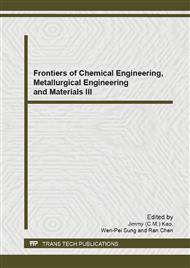p.225
p.229
p.233
p.239
p.243
p.247
p.251
p.255
p.260
Application of Rabbit Protein in Calligraphy Paper
Abstract:
Rabbit is a traditional textile material and has protein content about 93%. Rabbit hair wastes are abundantly present in textile processing due to its poor spinnability. In order to recycle the waste rabbit fiber effectively, the rabbit protein was researched. The papermaking method was performed for the first time and their properties of the hybrid paper were discussed in this study. Different contents of rabbit protein were successfully prepared and mixed with pulp fibers to remade papers. Finally, performances of these papers were characterized. The results showed that the surface of the rabbit protein paper was flat, white and writing fluently. The ink absorbance of novel paper increased. Moreover mechanical properties of the rabbit protein paper were stronger than the untreated paper. The folding endurance decreased firstly and then increased.
Info:
Periodical:
Pages:
243-246
Citation:
Online since:
August 2014
Authors:
Keywords:
Price:
Сopyright:
© 2014 Trans Tech Publications Ltd. All Rights Reserved
Share:
Citation:


